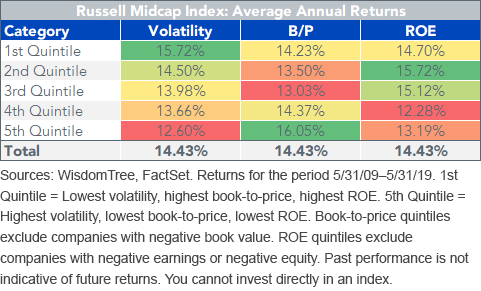Filtering Out the Noise in Mid-Caps


U.S. mid-caps have outperformed large caps over the past decade.1
According to the efficient market hypothesis (EMH), this should tend to be the case over the long run. EMH says market prices reflect all available information, and any excess returns are simply a by-product of greater risk.
Let’s run with this theory of higher risk being behind higher returns: How have riskier mid-caps done relative to less-risky mid-caps?
Mid-Cap Inefficiency?
The most straightforward way we can measure risk is by volatility, or standard deviation of returns. The least-volatile quintile of mid-caps outperformed the most volatile quintile by over 300 basis points (bps) annually. For proponents of efficient markets, this performance could be puzzling.
But we can also look at “value” stocks. If prices reflect all available information, then riskier stocks must be discounted to compensate investors for taking that risk. The first quintile of stocks sorted by book-to-price (B/P)—the most inexpensive, riskiest stocks—underperformed the fifth quintile by 183 bps.
Lastly, sorting the market on profitability—or return-on-equity (ROE)—the most profitable companies can be viewed as less risky than the least profitable. The least profitable are more likely to be distressed businesses. Here, the top three quintiles handily outperformed the bottom two quintiles on profitability.

Why did we run through the performance of these different cuts of the market? To show that over this relatively long time frame of 10 years, it doesn’t seem that the EMH of higher risk leading to higher returns held up. The lower-risk stocks as measured by volatility, valuations and profitability all outperformed.
Of course, you should take this 10-year exhibit with a grain of salt when comparing it with research conducted with sometimes 100 years or more of market returns. But asset allocators tend to make decisions based off performance over the last 3, 5 or 10 years.
And this past decade of performance seems to enforce WisdomTree’s core belief in an alternative to the EMH.
When WisdomTree was doing its original research on fundamental indexing in the early 2000s, it was clear to us that markets are not always perfectly efficient. Nothing showed this more clearly than the triple-digit P/E ratios of some tech stocks during the tech bubble.2
That’s why we believe stock price movements are better explained by the noisy market hypothesis. Markets are generally efficient, but stocks may be bought, sold or held for any number of reasons unrelated to the fundamental value of the firm—liquidity, taxes, animal spirits or any other common investor behavioral biases.
Because market prices can deviate from fundamentals at any given time, indexes that rebalance back to a measure of fundamentals other than price may offer better returns without necessarily having to increase risk.
Within WisdomTree’s suite of dividend-weighted Funds launched in 2006, the more inefficient markets outside of large caps have provided the greatest relative value.
Take, for example, the performance of the WisdomTree U.S. MidCap Dividend Fund (DON) over the past decade.
This fund weights mid-cap dividend payers by their regular annual cash dividends, which always tethers weights back to a fundamental metric and away from price.
DON added excess return relative to its market cap-weighted S&P MidCap 400 Index benchmark without adding excess risk—as measured by its lower standard deviation, smaller maximum drawdown, down capture of 79% and beta of 0.86.

Click here for standardized performance of DON.
As of this writing, DON is currently trading at 15.2 times forward earnings, which is an 11% discount to the S&P MidCap 400 Index.3 Before 2019, the last time investors saw valuations this inexpensive for DON was in the mini economic slowdown of 2011–2012. Since the end of 2012, the fund has returned just over 12% annualized, about 100 bps higher than the S&P MidCap 400 Index.4
Conclusion
We’re almost 10 years into this economic cycle. But bull markets don’t die of old age.
This current soft patch in the economy—which has many investors convinced the Federal Reserve is going to cut rates multiple times this year—seems fully reflected in the valuations for DON. In our view, this bodes favorably for investors who have been waiting for years for more attractive valuations.
1Sources: Zephyr StyleADVISOR. Returns for the period 5/31/09–5/31/19. Mid-caps measured by the Russell Midcap Index; large caps measured by the S&P 500 Index.
2Jeremy J. Siegel, "Big-Cap Tech Stocks Are a Sucker Bet," The Wall Street Journal, 3/14/00.
3Source: WisdomTree, FactSet. Data as of 6/18/19.
4Source: Zephyr StyleADVISOR. Returns for the return 12/31/12–5/31/19.
Important Risks Related to this Article
There are risks associated with investing, including possible loss of principal. Funds focusing their investments on certain sectors and/or smaller companies increase their vulnerability to any single economic or regulatory development. This may result in greater share price volatility. Please read the Fund’s prospectus for specific details regarding the Fund’s risk profile.


